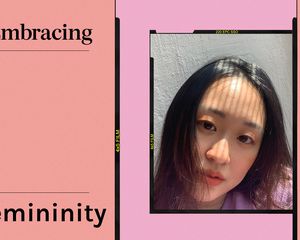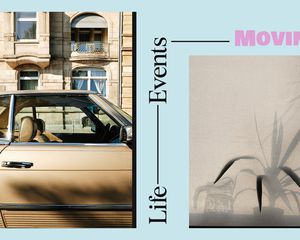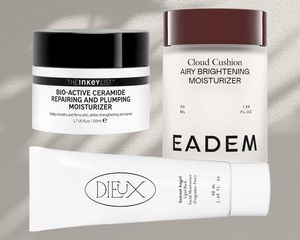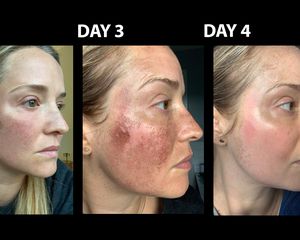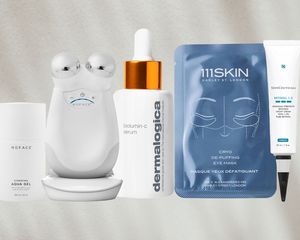:max_bytes(150000):strip_icc()/skin-picking-6d8e51defb944a93857a85a234e7fe08.png)
Stocksy
I remember exactly where I was when I began picking the skin on my left thumb nine years ago. I was standing in the shoebox-sized bedroom of my study-abroad homestay in Barcelona, Spain.
I remember the trance I fell into as I stood there, mindlessly picking the skin surrounding my nail until it bled and I had to cover it with a Band-Aid. I'm still not sure why it began in that bedroom in Barcelona—perhaps I was homesick and anxious. But from that moment forward, scanning for rough skin in that one particular area and picking until it bled became something I did, compulsively.
When, years after sticking to just that one thumb, I graduated to picking the other thumb, then my chin, and then my lips, I knew it was time for me to make conquering the compulsion a priority. If you have ever struggled with obsessive skin picking, keep reading for the strategies that helped me kick my habit after so many years.
Gain Awareness
It's crazy when you first start to focus awareness on when and why you pick, because you realize how un-random it is. For so long, I just didn't pay attention to where I was when I would snap out of the "zone" and realize I'd been ripping my skin to shreds. But then I started noticing that it happened in three primary places: movie theaters, my desk at work, and while watching TV at home.
These connections are key, because being aware of when you do it enables you to take the first steps towards controlling it.
I realized that I did it in movie theaters because the environment is dark, soothing, and conducive to uninterrupted picking. Watching a movie is a mindless task—you don't have to think about anything; you just sit back and passively take in the entertainment. Where else can you sit in the dark for two hours, wide awake and conscious, with free hands? As such, it became natural to engage in a dedicated picking session during movies, unseen and with nothing to snap me back to reality until the movie ended.
Watching TV at home was similar. Although not pitch black, it was a time when one mindless, trance-like activity begot another.
Picking at work was a bit different. The inherent nature of work is active, not passive like watching a movie or TV; and as a writer, my fingers aren't idle often. But I would find myself picking while staring at the computer screen any time I wasn't directly typing. The desk/computer-screen-picking-connection became most apparent after a holiday vacation. When I returned to my desk after a week out of office, and began picking at perfectly-healed and smooth thumbs, I realized I hadn't picked the entire time I'd been away.
Harness What Motivates You
We all have things that motivate us. For instance, a fear of wrinkles is a pretty powerful motivator for me—let alone early onset wrinkles. I typically would pick at my chin and lips without a mirror, but when I picked in front of a mirror for the first time and saw how engaged the muscles around my mouth were, well, it was sobering. My smile lines were tense and contracted, and deeply activated in the position I was contorting my mouth into in order to get a better picking advantage.
I could always feel and knew this was happening. After picking at my lips for long periods of time, my mouth muscles would get so tense and tired I'd have to take Advil. Like applying Neosporin and Band-Aids after making my cuticles bleed, it was always just part of the ritual. But to see it happening was a different story.
Being in the beauty industry, I know firsthand how squinting in the sun is one of the leading causes of crow's feet. The small, repetitive motion of the muscles contracting leads to the formation of those wrinkles more than anything other than age (Botox works because it's injected into the muscle to stop it from repeatedly contracting, and that's what stops the wrinkles from forming). So I knew that the small, repetitive contraction of my mouth muscles while picking was going to give me marionette lines I didn't want.
With that visual in mind, I was more easily able to train myself to stop picking before I slid into trance zone, and then eventually to stop altogether.
Thumb-wise, the longest period I ever went without picking was leading up to my best friend's wedding. I couldn't bear the thought of helping her with her beautiful white dress, with bloody thumb bandages on. I wanted my fingers to look pretty and feminine in photos, and to be able to toast a glass of champagne without a visible—and worse, self-inflicted—injury.
Find what motivates you to stop—whether that's fearing wrinkles/scars, visualizing a future event, researching the gross amount of germs you've got on your fingers at any given time, or something else. The germ/infection argument never stopped me from picking, but if you're motivated by that kind of thing, arming yourself with scary health numbers could help you turn off the switch each time you start to pick.
Stay Busy
Staying busy, and keeping your fingers busy, is essential for pickers who are trying to train themselves to stop. I found that the busier I was, the less time I had to pick, logistically speaking. If you're running errands, doing yoga, shopping with friends, walking a dog, writing a letter, you can't pick. You don't have the ability to be doing something active and simultaneously picking. Even when I was on vacation and not picking, it was because I was doing new and interesting things. It was those down times for me, sitting on a couch watching TV, that were seductive.
Which is why when you're not busy, you have to find a way to keep your fingers preoccupied. Whether while sitting on a train or plane, or in a movie, always have something you can run your fingers over so they aren't scanning your skin for things to pick. A sweet friend gave me a pair of Tibetan beads that I kept on me at all times while I was breaking the habit. I retrained myself to fiddle with them when the urge struck, instead of picking at my problem areas.
Seek Support
Don't be afraid to seek support—from friends, family, and professionals. Loved ones can help point out triggers, and kindly try to offer up distractions during those times you start to fixate on picking. It can also help just to talk to someone about dealing with the problem, so you don't feel isolated in handling it alone.
A professional can also be deeply relieving to talk to, and can help you address any underlying reasons you might have for picking, from stress and anxiety to learned behavior.
Stay Positive
Lastly, I found it incredibly helpful in my healing process to stay positive. When I was doing really well, and then had a setback, I was bummed, no doubt. But I knew that getting down on myself or demoralized wouldn't help. It was much more effective to brush it off, stay cheerful, and not obsess over the "mistake." Doing so only breeds more anxiety and negative emotions around the act of picking, while bringing more of a focus to the spot you picked, which, in turn, only makes you want to pick more.
If you just picked, or if you don't pick for two weeks or longer, and then fall off the horse, it's okay. Dust off your shoulders, brush it off, (or as Taylor would say, shake it off), and keep trying. Remember that the skin is a regenerative organ with an amazing capacity to heal itself. And if you do pick, keep in mind these post-picking solutions to help minimize damage.
We hope this helps, and tell us below: Do you currently struggle with picking? If you're someone who has cured yourself of a bad skin-picking habit, how did you do it? Share your tips below.

